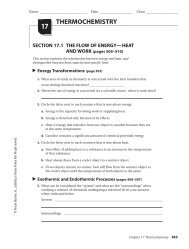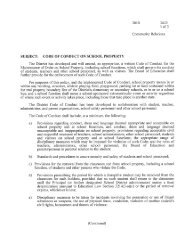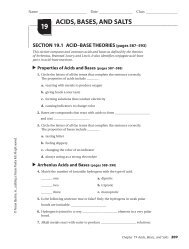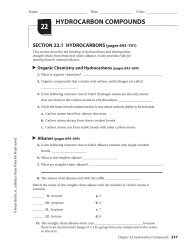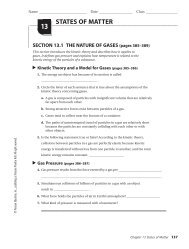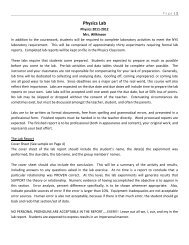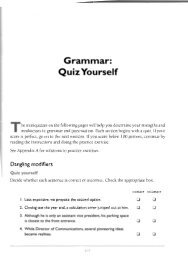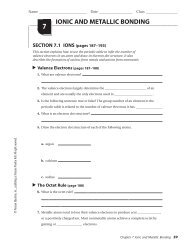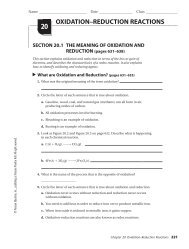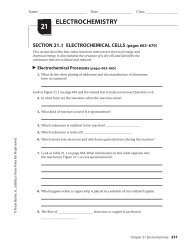NUCLEAR CHEMISTRY
NUCLEAR CHEMISTRY
NUCLEAR CHEMISTRY
Create successful ePaper yourself
Turn your PDF publications into a flip-book with our unique Google optimized e-Paper software.
© Pearson Education, Inc., publishing as Pearson Prentice Hall. All rights reserved.Name ___________________________ Date ___________________ Class __________________CHAPTER 25, Nuclear Chemistry (continued)5. Complete the table below showing changes in charge and number of neutronsand protons for different types of nuclear decay.Reason Nucleus Is Unstable Type of Decay Change in Change in Number ofNuclear Charge Protons and NeutronsToo many neutronsBeta particle1p increases by 1n decreases by 1Too many protonsElectron capture1p decreases by 1n increases by 1Too many protonsPositron (Beta particle)1p decreases by 1n increases by 1Too many protons and neutronsAlpha particle2p decreases by 2n decreases by 2Half-Life (pages 804–806)the time it takes for half of the nuclei in a radioactive sample to6. What is half-life?decay7. Look at Table 25.3 on page 805 to help you answer the following questions.a. What is the half-life in years of carbon-14? ________________________________5730 years (or 5.73 10 3 years)b. How many years old is an artifact that contains 50% of its original carbon-14?An artifact that contains 25% of its original carbon-14?5730 years; 11,460 yearsc. What radiation is emitted when potassium-40 decays?Beta particles and gamma rays are emitted.d. What is the half-life of potassium-40? _______________________________________1.25 10 9 yearse. Which isotopes listed in Table 25.3 have a half-life similar to that ofpotassium-40? ____________________________________________________________uranium-235 and uranium-238270 Guided Reading and Study Workbook
Name ___________________________ Date ___________________ Class __________________8. The decay reaction below shows how a radioactive form of potassium foundin many minerals decays into argon (gas). Fill in the missing mass numberand atomic number for the argon isotope that results from the decay of potassium-40.4019K –10 e JKL4018ArTransmutation Reactions (pages 807–808)9. The conversion of an atom of one element to an atom of another element iscalled ______________________ transmutation .10. What are two ways transmutation can occur?It can occur by radioactive decay orby bombardment of the nucleus of an atom with a high-energy particle.11. Uranium-238 undergoes 14 transmutations before it reaches the stable isotope______________________ lead-206 .12. Is the following sentence true or false? All transuranium elements weresynthesized in nuclear reactors and accelerators. ______________________trueReading Skill Practice© Pearson Education, Inc., publishing as Pearson Prentice Hall. All rights reserved.By looking carefully at photographs and graphs in your textbook, you help yourself understandwhat you have read. Look carefully at Figure 25.5 on page 804. What important idea does thisgraph communicate? If you were to extend the curve indefinitely, would the percent of radioisotoperemaining ever cross 0%? Why or why not? Do your work on a separate sheet of paper.The graph shows that for any radioactive element, after each period of time equal to the half-life, thepercent of the original radioisotope remaining is cut in half. Because the percent remaining is alwayspositive, half of that is always positive, so the curve would never cross 0%.Chapter 25 Nuclear Chemistry 271
© Pearson Education, Inc., publishing as Pearson Prentice Hall. All rights reserved.Name ___________________________ Date ___________________ Class __________________CHAPTER 25, Nuclear Chemistry (continued)SECTION 25.3 FISSION AND FUSION OF ATOMICNUCLEI (pages 810–813)This section describes nuclear fission and nuclear fusion. It discusses theirpotential as sources of energy, methods used to control them, and issuesinvolved in containment of nuclear waste.Nuclear Fission (pages 810–811)1. When certain heavy isotopes are bombarded with ______________________ neutrons ,they split into smaller fragments.2. Use the following labels to complete the diagram below: fission, fissionfragments, and neutrons/chain reaction.Neutrons/Chain reactionFissionKrypton-9191Kr36EnergyFission fragments23592 UUranium-235(fissionable)23692 UUranium-236(very unstable)14256 BaBarium-1423. The uncontrolled fission of 1 kg of uranium-235 can release energy equal to______________________ 20,000 tons of dynamite.4. Look at Figure 25.11 on page 811. This figure shows the basic components of anuclear power reactor.a. What part of the reactor contains the nuclear fuel?The fuel rods contain the nuclear fuel.b. What are the two parts of the reactor that control the fission reaction, oneby reducing the speed of neutrons, the other by absorbing neutrons?These parts are the moderator and the control rods.c. What is the role of the coolant?The coolant removes heat from the reactor core.The heat is used to generate steam.272 Guided Reading and Study Workbook
Name ___________________________ Date ___________________ Class __________________Nuclear Waste (page 812)5. Which parts of a nuclear reactor must be removed and replaced periodically?______________________fuel rods6. Look at Figure 25.12 on page 812. Where are spent fuel rods stored in a typicalnuclear power plant?They are stored in racks at the bottom of a pool.Nuclear Fusion (page 813)7. Look at Figure 25.13 on page 813. What happens to each pair of hydrogennuclei during nuclear fusion?They combine and produce two positions and a helium nucleus, with the release ofenergy.8. What problem has prevented the practical use of nuclear fusion?The temperatures required to start a fusion reaction make it difficult to contain andcontrol.SECTION 25.4 RADIATION IN YOUR LIFE (pages 816–819)This section explains three methods of detecting radiation and describesapplications of radioisotopes in medicine and research.© Pearson Education, Inc., publishing as Pearson Prentice Hall. All rights reserved.Detecting Radiation (page 816–817)1. Why are beta particles called ionizing radiation? They have enough energy toknock electrons off some atoms of the bombarded substance to produce ions.2. A device that detects flashes of light after ionizing radiation strikes a speciallycoated phosphor surface is called a ______________________________ scintillation counter .Using Radiation (pages 818–819)3. How is neutron activation analysis used?It can be used to detect trace elements in a sample.4. Look at Figure 25.15 on page 819. How is radioactive iodine-131 being used asa diagnostic tool? Doctors can diagnose thyroid conditions from scanned imagesbecause iodine-131 is absorbed by the thyroid gland.Chapter 25 Nuclear Chemistry 273
© Pearson Education, Inc., publishing as Pearson Prentice Hall. All rights reserved.Name ___________________________ Date ___________________ Class __________________CHAPTER 25, Nuclear Chemistry (continued)GUIDED PRACTICE PROBLEMSGUIDED PRACTICE PROBLEM 7 (page 806)7. Manganese-56 is a beta emitter with a half-life of 2.6 h. What is the mass ofmanganese-56 in a 1.0-mg sample of the isotope at the end of 10.4 h?AnalyzeSolveStep 1. What are the known values?(t 1/2 ) 2.6 h, initial mass 1.0 mg, elapsed time 10.4 hStep 2. How many half-lives have passed during the elapsed time?Number of half-lives elapsed time 10.4 h 4 half-lives2.6 h/half-lifet 1/21Step 3. Multiply the initial mass by for each half-life.21 1 1 1 1.0 mg ______________________ 2 2 2 2 _________________ mg Mn-56EvaluateStep 4. How do you know your answer is correct?should be much lower than the original mass.0.063The mass after four half-livesEXTRA PRACTICE (similar to Practice Problem 7, page 806)7. Iodine-126 is a beta emitter with a half-life of 13 days. What is the mass ofiodine-126 in a 8.0-mg sample of the isotope at the end of 39 days?39 days13 days/half-life1 1 1 3 half-lives; 8.0 mg 1.0 mg2 2 2GUIDED PRACTICE PROBLEM 8 (page 806)8. A sample of thorium-234 has a half-life of 24.1 days. Will all the thoriumundergo radioactive decay in 48.2 days? Explain.Step 1. How many half-lives have48.2 days 2passed in 50 days?24.1 days/half-lifehalf-livesStep 2. What fraction of the thoriumwill remain after 50 days?11 1 2 4 2No; one-fourth of the original mass willStep 3. Will all the thorium decay in50 days? Explain.remain.274 Guided Reading and Study Workbook



